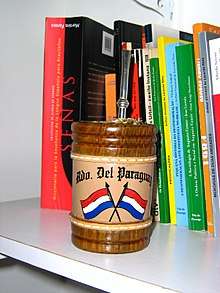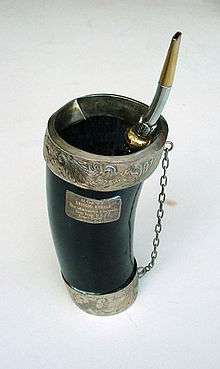Tereré
Tereré or Terere (of Guaraní origin[2]) is an infusion of yerba mate (botanical name Ilex paraguariensis), similar to mate but prepared with cold water and ice rather than with hot water,[3] and in a slightly larger vessel. This infusion has its roots in Pre-Columbian America, which established itself as traditional in the Guaranitic region during the time of Guaraní-Jesuit Missions, just as the Jesuit chronicles of the 17th and 18th centuries give certainty.[4]
 Traditional guampa made of palo santo, a typical wood in Paraguay. | |
| Type | Infusion, cold |
|---|---|
| Country of origin | Guaraní-Jesuit Missions[1] |

The Guaraní people call this infusion ka'ay,[5] where ka'a means herb and y means water.
First of all was consumed by the Guaraní natives. It was strengthened during the Guaraní-Jesuit Missions time in the area of that missions. Tereré was spread by the dwellers of that region, and for centuries was a social beverage. People usually prepare one jar of natural water and a "guampa/mate/porongo" (Spanish) / "cuia" (Portuguese) with a "bombilla" (Spanish) / "bomba" (Portuguese) which is shared among the group of people. That area of the Guaraní-Jesuit Missions have a fairly hot climate and this drink is believed to refresh the body and can be a very low-calorie, non-alcoholic beverage. Additionally, it is an important ritual signifying trust and communion.
Many people drink tereré with added medicinal herbs, both medicinal and refreshing. In northeastern Argentina it is commonly prepared either with water, medicinal herbs and ice cubes (called "tereré de agua" (tereré prepared with water)) or citrus, as in south-western Brazil, fruit juices like: lemon, lime, orange or pineapple. Although this practice varies depending on the region, since in Formosa Province (Argentina) it is more normally prepared with medicinal herbs. In Paraguay it is usually prepared with medicinal herbs, with the exception of the citrus juice preparation which is often prepared in the South of that country. Mixing fruit juices with tereré is commonly called "tereré de jugo" (tereré prepared with juice)-in northeastern Argentina- or "tereré ruso" (Russian tereré) -more used in Paraguay- because this practice is more common with Slavic immigrants in the northeast of Argentina and southern paraguay.
Guampas/Mates/Cuias are a kind of glass that can be made from animal horns, usually made from cattle horns, but some people made guampas from stainless steel, wood, mate/porongo (a kind of cucurbit native from South America), or silver. The new guampa/mate/cuia or the one not used for some time needs to be watered before use, because the lower part of the cuia is usually capped with a round piece of wood. By filling the guampa/cuia with water the wood expands, covering all leaks in the guampa/cuia. Guampas, mates and Cuias are also made from wood and covered in leather or steel.
Bombilla is a metal straw with a filter at the end. The yerba mate is placed at the bottom of the guampa, and as water is added the bombilla drinks from the guampa the clear green liquid.
Tereré in Argentina
In Argentina, depending on the region of the country and/or the person who primes it, it is taken with medicinal herbs and cold water with ice cubes or with some citrus juice, usually prepared with the envelope juices. It is normally consumed in hot days for most of the people in that region, where is considered part of the regional culture from the time before Columbus.
Tereré is part of the diet of native peoples, such as the Qom people, who consume it within their diet based on stews and "torta fritas/chipá cuerito". An investigation revealed that more than 90% of the qom they consume will have very often during much of the day.[6]
In Argentina there are politic bills to declare the "tereré de agua" (water tereré) as "official drink of Formosa Province".[7] y para declarar un Día Nacional Argentino del Tereré.[8]
Tereré in Paraguay
Tereré is a typical, popular drink from Paraguay where it is common to see students, friends, co-workers or families drinking tereré together during the summer, a time when temperatures reach 40 to 45 °C (104 to 113 °F). Some people put medicinal herbs or "yuyos" into the water to treat ailments such as headaches, stomach aches and high blood pressure.
Production of customized vacuum flasks "termos" for the water and guampas is common. These termos usually consist on a leather-covered 2-Liter thermos commonly filled with iced water and "yuyos" (medicinal herbs). The thermos has a leather cup-shaped space on the side for the leather-covered guampa. The guampas and leather-covered vacuum flasks are often personalized with names or logos. It's common to see people on the streets carrying these thermos by a leather strap for convenience.
Preparation
Most preparations of tereré begin by filling a cured yerba mate gourd, guampa 2/3 to 3/4 full of yerba mate.[9][10] Then, ice cubes and/or herbs are added to the water on to the vacuum flask. The drinking vessel is then filled with ice water. At this point, a mate straw (bombilla 'or' bombilla para mate)[11] is inserted through the mixture to the bottom of the vessel, while a thumb is kept over the bombilla tip in order to keep it from becoming clogged.[12] The liquid is consumed through the straw, and refilled as desired.
Some of the more popular juices and fruits to use in tereré are lime, orange, lemon, mango, peach, or grapefruit. Some of the more popular herbs to use in tereré are peppermint, boldo, lemongrass, or lemon verbena. Of course, any herb or juice could be added, even beer and lime cola have their supporters.[12]
References
- (Página 4) "EL PADRE PEDRO DE MONTENEGRO, 1711. SU TRATAMIENTO DE HERBORISTERAPIA PARA LAS AFECCIONES MENTALES Y SUS REFERENCIAS A LA MEDICINA HIPOCRÁTICO-GALÉNICA" - Published in the Memories of 14th Investigation Session. Third meeting of investigatos of Psychology from MERCOSUR.
- "Tereré in RAE dictionary"
- (in Spanish) ¿QUE ES EL TERERE? (Paraguay)
- (Página 4) "EL PADRE PEDRO DE MONTENEGRO, 1711. SU TRATAMIENTO DE HERBORISTERAPIA PARA LAS AFECCIONES MENTALES Y SUS REFERENCIAS A LA MEDICINA HIPOCRÁTICO-GALÉNICA" - Published in the Memories of 14th Investigation Session. Third meeting of investigatos of Psychology from MERCOSUR.
- "Diccionario Guaraní Interactivo". www.uni-mainz.de. Retrieved November 23, 2017.
- Lagranja, Elena Sofía; Valeggia, Claudia; Navarro, Alicia (2013). Prácticas alimentarias y actividad física en adultos de una población Toba de la provincia de Formosa, Argentina. Diaeta. 32. Asociación Argentina de Dietistas y Nutricionistas Dietista. ISSN 1852-7337.
- Diario El Territorio - "Formosa quiere declarar al tereré como bebida oficial". Viernes 8 de marzo de 2013. (Consultado el 07/Diciembre/2019)
- Diario El Territorio - "Diputados buscan instaurar el Día Nacional del Tereré". Thursday 30 August/2018. (Consulted 07/December/2019)
- "Todo sobre el tereré". Retrieved November 23, 2017.
- "¿Cómo hacer un mate tereré? - Rincón Recetas". rinconrecetas.com. Retrieved November 23, 2017.
- "Comprar bombilla para mate - El Mate". mate.com.es. March 27, 2009. Retrieved November 23, 2017.
- "Terere". ma-tea.com. Retrieved May 30, 2013.
Further reading
- Asunción 1537: Madre de la gastronomía del Río de la Plata y de Matto Grosso do Sul. Vidal Domínguez Díaz (2017).
- Poytáva: Origen y Evolución de la Gastronomía Paraguaya. Graciela Martínez (2017).